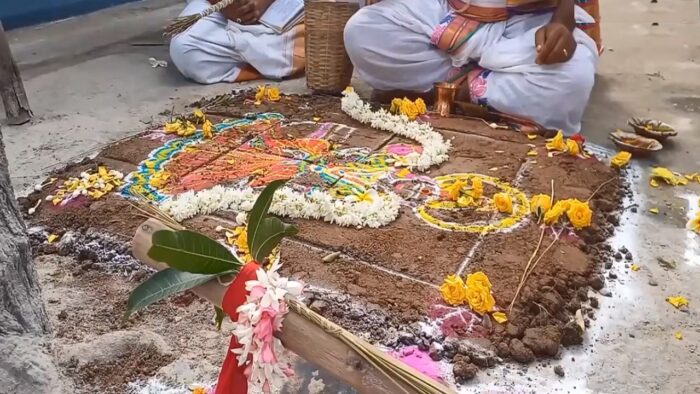Introduction
Hinduism has been held up widely as an example of a bioethical religion that is in harmony with nature and therefore inherently environment friendly.
The Bhūmi Sūkta of the Atharva Veda “celebrates the role of the earth as the home of ‘hills, snowy mountains, forests… who bears many plants and medicinal herbs… what forest animals of yours, wild beasts in the woods, lions, tigers go about man-eating – the jackal, wolf, O earth…’ (XII.1)” (Krishna, 2017). Dwivedi cites the Hindu view of the sacredness of all creation and idea of divinity as the underlying unifying power as against a separate monarchical God as contributing to the concept of human responsibility towards protection and co-existence (Gottlieb 1996).
The Hindu Declaration on Climate Change “presented at the 2009 Melbourne Parliament of the World’s Religions, affirms that ‘the Hindu tradition understands that man is not separate from nature, that we are linked by spiritual, psychological and physical bonds with the elements around us… [Hindus] hold a deep reverence for life and an awareness that the great forces of nature—the earth, the water, the fire, the air and space—as well as the various orders of life, including plants and trees, forests and animals, are bound to each other within life’s cosmic web” (Lal, 2015).
In contrast, scholars have held up the Western idea of conquering nature as reflected even in the development of an especially violent plow, with a vertical knife and horizontal share to slice through the soil. “The friction of this plow with the soil was so great that it normally required not two but eight oxen. It attacked the land with such violence that cross-plowing was not needed, and fields tended to be shaped in long strips” (White, 1967).
This paper looks at a minor Śaiva temple ritual called mṛtsaṅgrahanam with the lens of ecotheology in order to verify the hypothesis that temple rituals are a reflection of the environmental spirit of the tradition and analyze what, if any, environmental relevance one can draw from there.
The Context
Every large temple ritual, like the yearly utsava festival or the kumbhābhiṣeka consecration ceremonies, includes a preparatory ritual called aṅkurārpaṇam. This ritual involves the planting of seeds in pālikā pots and offering of the resulting sprouts. This is intended to start with an auspicious creative process as well as serve as an omen – the quality of the sprouts signifies the quality of outcome of the larger ritual.
As with every ritual, the deeper philosophical meaning signifies the process of sṛṣṭi or creation, part of the five-fold function of the Lord, Pati, in Śaiva Siddhānta.
Within the aṅkurārpaṇa ritual, there is a separate ritual process of collecting the soil for the pālikā pots. This is called mṛtsaṅgrahaṇam, or the ritual collecting of soil.
The Ritual Process
The Sūkṣmāgama[1] describes the process of mṛtsaṅgrahaṇam in the chapter on Aṅkurārpaṇavidhi. First the ācārya carries the required material in a procession around the temple, to the place from where the soil is to be collected. This could be the river bank, soil from the sides of the temple well, tank or the sacred temple tree, the sthalavṛkṣa.
A sthaṇḍila altar is made at the head of the place from where the soil is to be collected. The place is leveled and a matrix of nine parts is drawn on which Mother Earth is drawn as Bhūmādevī.
Different deities are invoked in the different parts and worshipped including Vighneśa, Brahma, Anantā, Vinatā, Bhadrā, Jayantā, Bhramarī, Bhramā, Prasthitā, Parijhṛṁbhī, Śūlinī in all the directions.
Then all the deities are requested to leave that particular space, since soil is to be collected there for the worship of Lord Śiva.
Then the kundālī hoe is worshipped and the ācārya uses the hoe to dig and collect soil from the garbha of Mother Earth. The collected soil is kept in a plate and covered with a new cloth. The dug area is leveled and worshipped again and drenched with consecrated waters from the sthaṇḍila.
Relevance
It might beg the question of how significant a minor ritual in the canon could be to the everyday environmental impact of Hinduism as a religion.
First, the philosophy is encoded like a fractal in every ritual. The practices are so consistent with each other and with the deeper universal construct of the tradition. Therefore each ritual is a perfect example of the spirit of the tradition. The mṛtsaṅgrahaṇam process establishes the point of view of the tradition that even for a dharmic activity sanctioned by the religion, for the purpose of worship that is core to the religion, one is not to haphazardly lay claim to nature’s resources. By invoking Mother Earth, and requesting permission to use, one is positioned not as an owner who dominates and not even as a steward who condescends to take care of his charge but as a child who receives humbly from the mother.
Next, by invoking and worshipping the deities in the different directions, the tradition shows the pervasive divinity of nature. Furthermore, the idea is that not only is nature divine by itself, it is also permeated by other divine entities.
Next, by requesting all residents of the space to relocate in order that the space may be used, the tradition demonstrates that human beings are but a small part of the diverse beings that rely on nature. One needs to co-exist with all beings and be respectful of their space.
Next, the act of leveling the ground and drenching it with milk and sanctified water is especially poignant, as if to seal the cut of the hoe in the womb of Mother Earth and heal the wound with nourishing fluids. It signifies that one has to return the space to how it was before, and one is responsible for replenishing what one has taken. It points to protection and sustainable use.
Counterview
There is a counterview that sacred rituals might signify ‘bio-divinity’ but cannot translate to environmentalism in practice (Tomalin, 2004). However, it can be seen that everyday ritual follows sacred temple rituals very closely. The aṅkurārpaṇa ritual is seen in popular practice including festivals and wedding rituals across regional subcultures. Therefore the sum and substance of sacred rituals permeates to common practice even if the common practitioner is not fully conscious of the philosophy. The spirit of the tradition is integrated into everyday life through these rituals.
Conclusion
Recent research and developments in religious environmentalism reflects the growing consciousness of the validity of traditional and indigenous relationships with nature and efforts to begin the long reparation process of the breakdown of this relationship, “joining traditional indigenous ideologies that view land as a “being” needing protection and preservation in order to prevent resource depletion” (White, 2018). The Universal Declaration of the Rights of Mother Earth also echoes this view, arguing for a legal view of Mother Earth as a living entity[2].
It can be amply demonstrated that the idea of Mother Earth as a living being is already encoded in Hinduism. The mṛtsaṅgrahaṇam ritual is the perfect illustration of this ethos.
Bibliography
A. Primary sources
SŪKṢMĀGAMA. Vol. I. ( 2010). Eds. S. Sambandhaśivācārya and T. Ganesan. Pondicherry: French Institute of Indology.
B. Secondary sources
Cort, John E. International Journal of Hindu Studies, vol. 4, no. 2, Springer, 2000, pp. 208–12, http://www.jstor.org/stable/20106732.
Krishna, Nanditha. (2017). Hinduism and Nature. Penguin Random House.
Lal, Vinay. “Climate Change: Insights from Hinduism.” Journal of the American Academy of Religion, vol. 83, no. 2, [Oxford University Press, American Academy of Religion], 2015, pp. 388–406, http://www.jstor.org/stable/24488052.
Tomalin, Emma. “Bio-Divinity and Biodiversity: Perspectives on Religion and Environmental Conservation in India.” Numen, vol. 51, no. 3, Brill, 2004, pp. 265–95, http://www.jstor.org/stable/3270584.
White, Hannah. “INDIGENOUS PEOPLES, THE INTERNATIONAL TREND TOWARD LEGAL PERSONHOOD FOR NATURE, AND THE UNITED STATES.” American Indian Law Review, vol. 43, no. 1, [University of Oklahoma College of Law, Board of Regents of the University of Oklahoma], 2018, pp. 129–65, https://www.jstor.org/stable/26632875.
White, Lynn. “The Historical Roots of Our Ecologic Crisis.” Science, vol. 155, no. 3767, American Association for the Advancement of Science, 1967, pp. 1203–07, http://www.jstor.org/stable/1720120.
[1] paricārakam āhūya soṣṇīṣam sottarīyakam ||
sthālikām pañcagavyaṁ ca havirastreśamūrtinam |
śirasā vāhayitvā tu sarvālaṅkāra śobhitam ||
dhāmapradakṣiṇam kuryāt pūrve vā cottare’pi vā |
aiśānye vā prakartavyam mṛdaḥ sthānam samāviśet ||
astreśam paścime deśe vinyaset sthaṇḍilopari |
tadagre sthaṇḍilam kalpya navakoṣṭhena lekhayet ||
īśe tvekapadam kalpya vighneśam pūjayettataḥ |
puṇyāham vācayet tatra prokṣayedastra mantrataḥ ||
brahmāṇam madhyame’bhyarcya gandhapuṣpaissvanāmabhiḥ |
anantā vinatā bhadrā jayantā bhramarī bhramā ||
prasthitā parijhṛmbhī ca śūlinī ceśa gocare |
pūrvādīśāna paryantam arcayet svasvanāmataḥ ||
sadhūtaṁ gulasaṁmiśraṁdadyād dadhyodanaṁ balim |
tāmbūlaṁ dāpayet paścāt tṛpterarghyaṁ pradāpayet ||
udvāsya sarvadevāṁśca viṣṇumeva ca deśikaḥ |
mṛdam īśvarakāryārthaṁgṛhītvā tadanujñayā ||
etatsthānāśritā devā gacchatvaṁ hi yathāsukham |
iti vijñāpya saṁpūjya balimaṇḍalapūrvake ||
pañcagavyena saṁprokṣya kundālīṁ pṛuthivīṁ tathā |
navavastrena saṁveṣṭhya kūrcaṁ baddhā khanitrake ||
gandhapuṣpādinābhyarcya dhūpadīpādikaṁ dadet |
deśikaśca hṛdambhoje vinyaset śaktimantrataḥ ||
kundālyā khānayed bhūmim astramantratrayeṇa tu |
pidhāya navavastreṇa bhūmiṁ samatalaṁ guruḥ |
ādhāraśaktim abhyarcya dhūpadīpākam dadet ||
paricārakam āhūya soṣṇīṣaṁ sottarīyakam |
śirasā vāhayitvā tu gaje vā’’ropayed rathe ||
athavā pādagamanaiḥ sarvālaṁkāra śaṁyutam |
kuryān maṅgalavādyaiśca svasti sūkta samanvitam ||
śanaiḥ pradakṣiṇaṁ kṛtvā viśēdaṅkuramaṇṭapam |
puṇyāhaṁ vācayet tatra prokṣayet astramantrataḥ ||
saṅkalpya sthaṇḍile madhye candrakumbhaṁ nidhāya ca |
sodakaṁ kūrca saṁyuktam hemapallava saṁyutam ||
sasūtraṁ vastrasaṁyuktaṁ nālikera phalairyutam |
abhyarcya gandhapuṣpādyaiḥ madhye cāstraṁ prapūjayet ||
gandhādyair upacāraistu toṣayedoṣadhīśvaram |
pālikādīni sarvāṇi nyaset pūrvokta vartmanā ||
mṛdamīśāna mantreṇa pālikādiṣu nikṣipet |
tilasarṣapamudgāni māṣaśimbāḍhakāni ca ||
kulutthayavakārpāsabījaṁ kṣīrena secayet |
yā jātā iti mantreṇa dhānyapātraṁ spṛśan japan ||
muhūrtaṁ nirīkṣya deveśaṁpūjayeddeśikottamaḥ |
pālikādisamārabhya vāpayeddhṛdayena tu || Sūkṣmāgama 12.19-40 ||
[2] “The Universal Declaration of the Rights of Mother Earth has emerged as an international document that codifies rights of nature. Bolivia… has emerged as a leader in promoting the rights of nature. The nation hosted the World People’s Conference on Climate Change and the Rights of Mother Earth in 2010. This conference included over 32,000 people, a large number of which were indigenous. The result of this conference was the document entitled the “Act of the Rights of Mother Earth,” or the Earth Rights Declaration. The Earth Rights Declaration embodies Mother Earth as a living being with rights, including the right to live, exist, regenerate, and be protected and respected.75 These ideas are consistent with the beliefs of many indigenous people that their lives are
intertwined with Mother Nature and that it is their duty to live peacefully with and protect her.” (White, 2018)
Feature Image Credits: youtube.com
Hinduism&Environmentalism
Watch video presentation of the above paper here:
Disclaimer: The opinions expressed in this article belong to the author. Indic Today is neither responsible nor liable for the accuracy, completeness, suitability, or validity of any information in the article.








